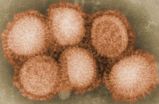(Press-News.org) AMES, Iowa – Wendy Wintersteen, dean of Iowa State University's College of Agriculture and Life Sciences, spoke on Sunday of the importance of public-private partnerships in strengthening global food security during the annual meeting of the American Association for the Advancement of Science in Chicago.
During her talk, part of a panel on research and development for sustainable agriculture and food security, Wintersteen stressed the importance of partnerships in providing the innovation necessary to meet global challenges.
She said climate change, pests, plant disease and other serious threats to global food security are too grave for any single agency or organization to solve alone. Instead, she urged universities, government agencies and private-sector organizations to find partnership opportunities to pool research and expertise.
"Research partnerships are an important way to leverage the strengths of federal, state and private contributors to achieve maximum benefits," Wintersteen said. "They help leverage scarce resources, provide exposure to diverse perspectives, build on long-term investments in research and development and get us closer to a shared vision for our future."
Wintersteen said such partnerships fit well with the mission of land-grant universities like Iowa State. "Partnerships in research, education and extension are encoded in the DNA of land-grant universities," she said. "The most successful engagement efforts we have are associated with strong, healthy relationships with partners in government, business and the nonprofit world."
She pointed to Iowa State's BioCentury Research Farm, a first-in-the-nation integrated research and demonstration site dedicated to biomass production and processing, as a success story of such an approach. More than a dozen industry and government partners are currently working with ISU scientists at the research farm on improved crop practices, more efficient harvesting, storing and transporting systems and advanced biomass conversion technologies.
Wintersteen said partnerships played an important role in elevating public investment in agricultural research to a national priority. She cited a 2012 report to President Obama from the President's Council of Advisors on Science and Technology, which calls for the creation of six multidisciplinary innovation institutes focused on emergency challenges in agriculture that would be supported by public-private partnerships.
INFORMATION:
The American Association for the Advancement of Science is an international non-profit organization that promotes science, engineering and innovation.
Contacts
Brian Meyer
College of Agriculture and Life Sciences
515-294-0706
bmeyer@iastate.edu
Fred Love
News Service
515-294-0704
fredlove@iastate.edu
Iowa State University's Wintersteen talks partnerships at national science meeting
2014-02-17
ELSE PRESS RELEASES FROM THIS DATE:
Scientists call for new stewardship of the deep ocean: Earth's last frontier
2014-02-17
The deep ocean, the largest domain for life on earth, is also its least explored environment. Humans are now encroaching more vigorously than ever into the ocean's deep regions, exploiting the deep's resources and placing its wealth of vibrant habitats and natural services for the planet at risk.
Lisa Levin, a biological oceanographer at Scripps Institution of Oceanography at UC San Diego, believes the vital functions provided by the deep sea—from carbon sequestration to nurturing fish stocks—are key to the health of the planet. As humans ramp up exploitation of deep-sea ...
Researchers rejuvenate stem cell population from elderly mice, enabling muscle recovery
2014-02-17
STANFORD, Calif. — Researchers at the Stanford University School of Medicine have pinpointed why normal aging is accompanied by a diminished ability to regain strength and mobility after muscle injury: Over time, stem cells within muscle tissues dedicated to repairing damage become less able to generate new muscle fibers and struggle to self-renew.
"In the past, it's been thought that muscle stem cells themselves don't change with age, and that any loss of function is primarily due to external factors in the cells' environment," said Helen Blau, PhD, the Donald and Delia ...
New 'pomegranate-inspired' design solves problems for lithium-ion batteries
2014-02-17
An electrode designed like a pomegranate – with silicon nanoparticles clustered like seeds in a tough carbon rind – overcomes several remaining obstacles to using silicon for a new generation of lithium-ion batteries, say its inventors at Stanford University and the Department of Energy's SLAC National Accelerator Laboratory.
"While a couple of challenges remain, this design brings us closer to using silicon anodes in smaller, lighter and more powerful batteries for products like cell phones, tablets and electric cars," said Yi Cui, an associate professor at Stanford ...
Worldwide study finds that fertilizer destabilizes grasslands
2014-02-17
Lincoln, Neb., Feb. 17, 2014 -- Fertilizer could be too much of a good thing for the world's grasslands, according to study findings to be published online Feb. 16 by the journal Nature.
The worldwide study shows that, on average, additional nitrogen will increase the amount of grass that can be grown. But a smaller number of species thrive, crowding out others that are better adapted to survive in harsher times. It results in wilder swings in the amount of available forage.
"More nitrogen means more production, but it's less stable," said Johannes M.H. Knops, a University ...
Study on flu evolution may change textbooks, history books
2014-02-17
A new study reconstructing the evolutionary tree of flu viruses challenges conventional wisdom and solves some of the mysteries surrounding flu outbreaks of historical significance.
The study, published in the journal Nature, provides the most comprehensive analysis to date of the evolutionary relationships of influenza virus across different host species over time. In addition to dissecting how the virus evolves at different rates in different host species, the study challenges several tenets of conventional wisdom, for example the notion that the virus moves largely ...
CU-Boulder stem cell research may point to new ways of mitigating muscle loss
2014-02-17
New findings on why skeletal muscle stem cells stop dividing and renewing muscle mass during aging points up a unique therapeutic opportunity for managing muscle-wasting conditions in humans, says a new University of Colorado Boulder study.
According to CU-Boulder Professor Bradley Olwin, the loss of skeletal muscle mass and function as we age can lead to sarcopenia, a debilitating muscle-wasting condition that generally hits the elderly hardest. The new study indicates that altering two particular cell-signaling pathways independently in aged mice enhances muscle stem ...
Years after bullying, negative impact on a child's health may remain
2014-02-17
BOSTON (Feb. 17, 2014) —The longer the period of time a child is bullied, the more severe and lasting the impact on a child's health, according to a new study from Boston Children's Hospital published online Feb. 17 in Pediatrics. The study is the first to examine the compounding effects of bullying from elementary school to high school.
"Our research shows that long-term bullying has a severe impact on a child's overall health, and that its negative effects can accumulate and get worse with time," says the study's first author Laura Bogart, PhD, from Boston Children's ...
Why does the brain remember dreams?
2014-02-17
This news release is available in French. Some people recall a dream every morning, whereas others rarely recall one. A team led by Perrine Ruby, an Inserm Research Fellow at the Lyon Neuroscience Research Center (Inserm/CNRS/Université Claude Bernard Lyon 1), has studied the brain activity of these two types of dreamers in order to understand the differences between them. In a study published in the journal Neuropsychopharmacology, the researchers show that the temporo-parietal junction, an information-processing hub in the brain, is more active in high dream recallers. ...
Transfer of knowledge learned seen as a key to improving science education
2014-02-16
CHICAGO -- (Feb. 16, 2014) -- Attendees of a workshop at the annual meeting of the American Association for the Advancement of Science will be immersed into "active learning," an approach inspired by national reports targeting U.S. science education, in general, and, more specifically, the 60 percent dropout rate of students in science, technology, engineering and mathematics (STEM).
"The goal of this session is to take many ideas around improving science education that are out there and make them applicable to the classroom," says Eleanor "Elly" V.H. Vandegrift, associate ...
Using crowdsourcing to solve complex problems
2014-02-16
If two minds are better than one, what could thousands of minds accomplish? The possibilities are endless -- if researchers can learn to effectively harness and utilize all that knowledge.
Northwestern University professor Haoqi Zhang designs new forms of crowd-supported, mixed-initiative systems that tightly integrate crowd work, community process and intelligent user interfaces to solve complex problems that no machine nor person could solve alone. Zhang's systems can ease challenges in designing a custom trip or planning an academic conference, for example.
Zhang ...


